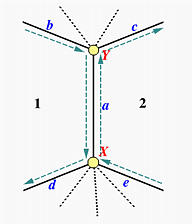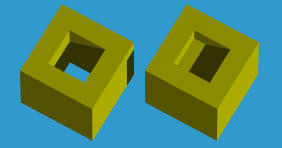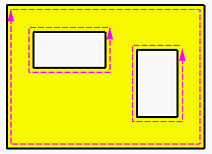

Perhaps the oldest data structure for a B-rep is Baumgart's winged-edge data structure. It is quite different from that of a wireframe model, because the winged-edge data structure uses edges to keep track almost everything. In what follows, we shall assume there is no holes in each face and later extend it to cope with holes. Moreover, we shall assume edges and faces are line segments and polygons. Topologically, one can always stretch curvilinear edges and faces so that they become flat without changing the relationships among them.

The above figure shows a polyhedron with vertices, edges and faces indicated with upper cases, lower cases and digits, respectively. Let us take a look at edge a = XY. This edge has two incident vertices X and Y, and two incident faces 1 and 2. A face is a polygon surrounded by edges. For example, face 1 has its edges a, c and b, and face 2 has its edges a, e and d. Note that the ordering is clockwise viewed from outside of the solid. If the direction of the edge is from X to Y, faces 1 and 2 are on the right and left side of edge a, respectively. To capture the ordering of edges correctly, we need four more pieces of information. Since edge a is traversed once when traversing face 1 and traversed a second time when traversing face 2, it is used twice in different directions. For example, when traversing the edges of face 1, the predecessor and successor of edge a are edge b and edge c, and when traversing the edges of face 2, the predecessor and successor of edge a are edge d and edge e. Note that although there are four edges incident to vertex X, only three of them are used when finding faces incident to edge a. Therefore, for each edge, the following information are important:


|
|
|||||||||||||||||||||||||||
The above shows the information for the entry of edge a. The four edges b, c, d and e are the wings of edge a and hence edge a is "winged."

The above is a tetrahedron with four vertices A, B, C and D, six edges a, b, c, d, e and f, and four faces 1, 2, 3 (back) and 4 (bottom). Its edge table is the following. Please use the above diagram to verify this table.
| Edge | Vertices | Faces | Left Traverse | Right Traverse | ||||
| Name | Start | End | Left | Right | Pred | Succ | Pred | Succ |
| a | A | D | 3 | 1 | e | f | b | c |
| b | A | B | 1 | 4 | c | a | f | d |
| c | B | D | 1 | 2 | a | b | d | e |
| d | B | C | 2 | 4 | e | c | b | f |
| e | C | D | 2 | 3 | c | d | f | a |
| f | A | C | 4 | 3 | d | b | a | e |

|
|
With this data structure, one can easily answer the question: which vertices, edges, faces are adjacent to each face, edge, or vertex. There are nine of these adjacency relations. For example, is vertex X adjacent to face 5? Are faces 3 and 5 adjacent to each other? The winged-edge data structure can answer these queries very efficiently and some of them may even be answered in constant time. However, it may take longer time to answer other adjacency queries. Note also that once the numbers of vertices, edges and faces are known, the size of all three tables are fixed and will not change.


There are two ways for resolving this problem:

